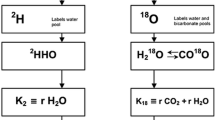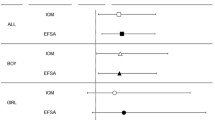Abstract
For healthy children up to 15 years of age, no data exist regarding water turnover as directly measured using stable isotope techniques. Water turnover was measured in 171 healthy children (88 girls, 83 boys, age: 6 weeks–15 years) whilst living in their normal environment. Water turnover was calculated from the equilibrium of2H2O concentration reached in the urine 2–3 h after an oral test load of 2 ml2H2O/kg and the subsequent elimination rate of2H2O. Daily water turnover decreased from 160 ml/kg (3 months), 100 ml/kg (12 months), 65 ml/kg (3 years) to 40 ml/kg at 15 years of age. Fluid intake was then calculated by subtracting the estimated metabolic water production from water turnover and this data was compared with recommended values. Our calculation of spontaneous daily fluid intake for these healthy children is within the recommended range during the 1st year of life, whereas for older children the recommendations exceed the spontaneous intake by a factor of 1,2–2.
Similar content being viewed by others
References
Arnold WC (1990) Parenteral nutrition, and fluid and electrolyte therapy. In: Arnold WC, Kallen RJ (eds) Fluid and electrolyte therapy. Pediatr Clin North Am 37(2):449–462
Ballauf A, Kersting M, Manz F (1988) Do children have an adequate fluid intake? Water balance studied carried out at home. Ann Nutr Metab 32:332–339
Ballauf A, Kersting M, Wember T, Manz F, Schöch G (1988) Grenzen der Zuverlässigkeit bei Ernährungserhebungen mit der genauen Wägemethode. Akt Ernähr 13:24–27
Barness LA (1987) Nutritional requirements. In: Nelson WE, Behrman RE, Vaughan VC (eds) Textbook of pediatrics 13th edn. WB Saunders, Philadelphia, pp 113–138
Böhles H (1989) Richtlinien zur Infusionsbehandlung. In: Emmrich P, Sitzmann FC, Truckenbrodt H (eds) Kinderärztliche Notfälle, 11th edn. Thieme, Stuttgart, pp 105–107
Burmeister W (1988) Wasser-, Elektrolyt- und Säure-Basen-Haushalt. In: Schulte FJ, Spranger J (eds) Lehrbuch der Kinderheilkunde, 26th edn. Fischer, Stuttgart, pp 105–107
Butte NF, Wong WW, Klein PD, Garza C (1991) Measurement of milk intake: tracer-to-infant deuterium dilution method. Br J Nutr 65:3–14
Dangel P, Jorch G (1989) Intensivbehandlung in der Pädiatrie. In: Lawin P (ed) Praxis der Intensivbehandlung, 5th edn. Thieme, Stuttgart pp. 58.1–58.56
Deutsche Gesellschaft für Ernährung (1989) Empfehlungen zur Nährstoffzufuhr. 4th edn. Umschau Verlag, Frankfurt, pp 23–25
Du Bois EF (1927) Basal metabolism in health and disease. 2nd edn. Lea and Febiger, Philadelphia, pp. 120–124
Fjeld CR, Brown KH, Schoeller DA (1988) Validation of the deuterium oxide method for measuring average daily milk intake in infants. Am J Clin Nutr 48:671–679
Friis-Hansen BJ, Holiday M, Stapleton T, Wallaca WM (1951) Total body water in children. Pediatrics 7:321–327
Fusch C (1985) Quantitative Analyse von D2O-Konzentrationen im Serum mit der Infrarot-Spektroskopie. Bestimmung von Gesamtkörperwasser und Wasserumsatz. Thesis, Tübingen, FRG
Fusch C, Moeller H (1988) Measurement of D2O concentrations at tracer levels in small samples obtained from paediatric patients. J Clin Chem Clin Biochem 26:715–721
Fusch C, Moeller H (1992) Measurement of water turnover using stable isotope technique: calculation of error propagation. Eur J Clin Chem Clin Biochem (in press)
Fusch C, Scharrer B, Hungerland B, Moeller H (1991) Water turnover of healthy children (abstract). Annual Meeting of the European Society of Pediatric Research, Zürich Switzerland, September 1991. Pediatr Res 6:635
Haley, HB, Edelman IS, Moore FD (1951) The turnover rate of body water in the human. Surg Forum 2:595–601
Holliday JM, Segar C (1957) The maintenance need for water in parenteral fluid therapy. Pediatrics 19:823–832
Lifson N, McClintock R (1966) Theory of use of the turnover rates of body water for measuring energy and material balance. J Theor Biol 12:46–74
Lugan RW, Arneil GC (1984) Fluid, electrolyte and acid-base disturbances. In: Forfar JO, Arneil GC (eds) Textbook of paediatrics, 3rd edn. Churchill Livingstone Inc, Edinburgh, pp 1295–1296
Lukaski HC, Johnson PE (1985) A smiple, inexpensive method of determining total body water using a tracer dose of D2O and infrared absorption of biological fluids. Am J Clin Nutr 41:363–370
Mendez J, Prokop E, Picon-Rategui E, Akers R., Buskirk ER (1970) Total body water by D2O dilution using saliva samples and gas chromatography. J Appl Physiol 28:354–357
Moore FD (1946) Determination of total body water and solids with isotopes. Science 104:157–160
Nielsen WC, Kryzwicki HJ, Johnson HL, Consolazio CF (1971) Use and evaluation of gas chromatography for determination of deuterium in body fluids. J Appl Physiol 31:957–961
Schloerb PR, Friis-Hansen BJ, Edelman IS, Solomon AK, Moore FD (1950) Measurement of total body water in human subjects by deuterium oxide dilution. With a consideration of the dynamics of deuterium distribution. J Clin Invest 29:1296–1310
Vio FR, Infante CB, Lara WC, Mardones-Santander F, Rosso PR (1986) Validation of the deuterium dilution technique for the measurement of fluid intake in infants. Hum Nutr Clin Nutr 40C:327–332
Wechsler JG, Maier E, Wenzel H, Fusch C, Moeller H, Ditschuneit H (1990) Bestimmung des Körperwassers — ein Vergleich zwischen Deuterium-(D2O)-, Impedanz-, Infrarot- und Calipermessung (Abstract). Infusionstherapie 17 [Suppl 1]:59
Weil WB, Bailie MD (eds) (1977) Fluid and electrolyte metabolism in infants and children: a unified approach. Grune and Stratton Inc, New York
Welle S (1990) Two-point vs multipoint sample collection for the analysis of energy expenditure by use of the doubly labeled water method. Am J Clin Nutr 52:1134–1138
Werner M, Kersting M, Manz F (1990) Untersuchung des Wasserhaushaltes bei 19 Kleinkindern in häuslicher Umgebung (abstract). Monatsschr Kinderheilkd 138:528
Wong WW, Cochran WJ, Klish WJ, O'Brian Smith E, Lee LS, Klein PD (1988) In vivo isotope-fractionation factors and the measurement of deuterium- and oxygen-18-dilution spaces from plasma, urine, saliva, respiratory water vapor, and carbon dioxide. Am J Clin Nutr 47:1–6
Author information
Authors and Affiliations
Rights and permissions
About this article
Cite this article
Fusch, C., Hungerland, E., Scharrer, B. et al. Water turnover of healthy children measured by deuterated water elimination. Eur J Pediatr 152, 110–114 (1993). https://doi.org/10.1007/BF02072485
Received:
Accepted:
Issue Date:
DOI: https://doi.org/10.1007/BF02072485




